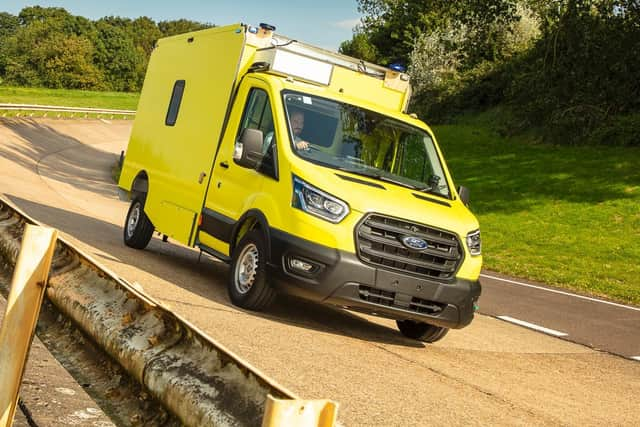Brighouse's Venari Group and Ford launch revolutionary new ambulance
and live on Freeview channel 276
Based on a Ford Transit chassis-cab, the vehicle made its global debut at the Emergency Services Show in Birmingham.
“Project Siren” is a new ambulance platform cleverly packaged to retain a weight limit under 3.5 tonnes, enabling National Health Service Ambulance Trust drivers and paramedics to drive the vehicle on a standard U.K. driving license.
Advertisement
Hide AdAdvertisement
Hide Ad“This project has grown from design to a finished vehicle in 12 months”, said Paul Baynes, marketing and sales manager, Special Vehicle Solutions, Ford of Europe.


“Ford has a long history in building ambulances and as we enter our most exciting stage in the history of Ford vehicle conversions, this is a project we’re immensely proud of. This vehicle sets out to make life easier for those busy saving other’s lives.”
Integral to Ford Pro, Ford’s new business for distribution and services, the Ford Venari Alliance marks the start of plans to grow and develop opportunities with key conversions partnerships, ensuring customers from every vocation have access to specialised vehicles.
“Project Siren has been the most immersive and intense project that I’ve been involved in, in over 15 years in the emergency vehicle market, said Oliver North, CEO, Venari Group. “To achieve our weight, functionality and digitised functionality targets required newly-formed engineering departments to be at their most creative every day.
Advertisement
Hide AdAdvertisement
Hide Ad“The result from the Ford Venari Alliance is nothing short of phenomenal – the first genuine, no-compromise 3.5 tonne ambulance on the global market which has raised the bar in every aspect of operational performance.”
* Support your Halifax Courier by becoming a digital subscriber. You will see 70 per cent fewer ads on stories, meaning faster load times and an overall enhanced user experience. Click here to subscribe
Improving patient treatment and paramedic ease of use
Using an agile, collaborative process and direct customer input from NHS Ambulance Trusts to create the new vehicle, “Project Siren” is designed to improve patient treatment and ease of use for paramedics.
Advanced digital connectivity supports efficient restocking and vehicle maintenance, while the lightweight design helps reduce emissions and operating costs associated with using heavier vehicles.
Advertisement
Hide AdAdvertisement
Hide AdThis digital connectivity offers an asset management solution, enabling paramedics and ambulance preparation teams to monitor the onboard equipment and stock levels – from boxes of plasters and gloves, to stretchers and defibrillators – ensuring equipment is not missing when the ambulance is deployed from the hospital or at the scene of any incident.
The digital asset tracking also supports faster restocking to shorten turnaround time, helping to improve ambulance availability.
Equipment and stock levels can be monitored through Ford’s Ambulance Pro Cloud software, developed in partnership with CSS Europe, and is transferable to other non-Ford ambulance fleets, where users are notified of missing equipment when logged in.
This software has been designed with vehicle uptime in mind, saving precious time for paramedics out on the road and ensuring compliance standards are met.
Advertisement
Hide AdAdvertisement
Hide AdA standout feature of the ambulance interior is the cabin technology layout, which revolutionises daily operation for its drivers and crew.
Aftermarket screens and monitors, usually fitted to gas-lift frames and often obscuring other dashboard controls on vehicles currently in service, have instead been incorporated within the lightweight ambulance’s eight-inch, dashboard-mounted touch screen.
In collaboration with EDAG Engineering Group, integration hardware and software enables ambulance routing and dispatch information to be displayed directly onto the same interior screen, which controls cabin climate and incorporates the automatic rear view camera.
This increases space and legroom in the cabin, aiding comfort for crews who may be sat behind the wheel for up to 10 hours a day. Ford’s new SYNC 4 system, introduced early next year in new Transit models, gains a new 12-inch touch screen to further enhance the user experience.
Advertisement
Hide AdAdvertisement
Hide AdClose collaboration with the Ford Pro Special Vehicles team has delivered further weight reduction through a “mix and match” approach to existing Transit parts versatility – including a thinner, lightweight windscreen (optional on some Transit models), alloy wheels in place of steel and optimised fuel reservoir and fluid tank sizes.
Extensive use of composite materials in place of existing industry-standard ply designs contributes significantly towards weight reduction, plus weight-optimised, bespoke integration of internal features – such as lockers built into the structure of the vehicle – reduces weight further.
Use of Ford’s rapid prototyping workshops has also enabled individual components to be tested in parallel for the fastest-possible development and of the highest quality. Further testing of the vehicle is underway currently across Ford’s European facilities, including the Lommel Proving Ground in Belgium, the Merkenich technical centre in Germany, and the Ford Britain Dunton Campus in Essex, home to Ford’s European Commercial Vehicles business line.
The ambulance’s configuration is also compatible with the new all-electric E-Transit, while the first diesel-powered ambulances are available to order now and will arrive with customers from early next year.